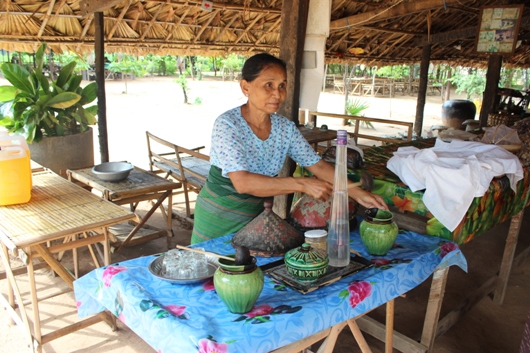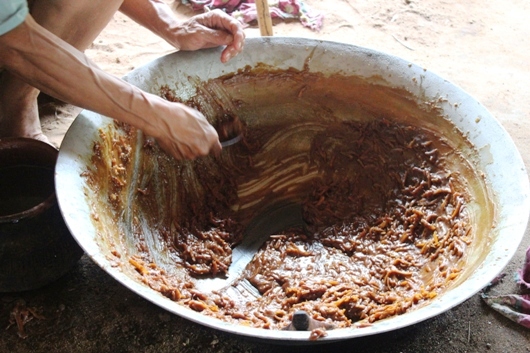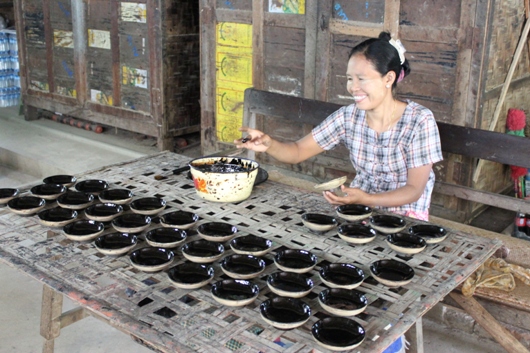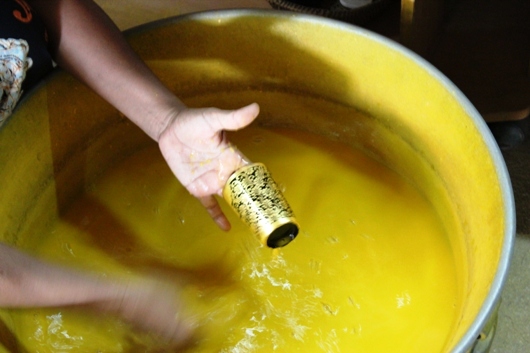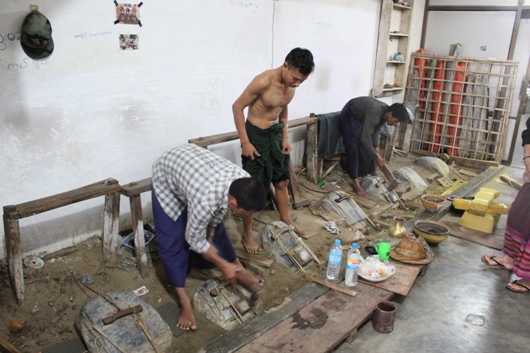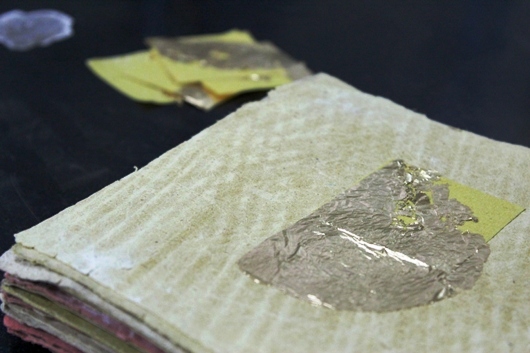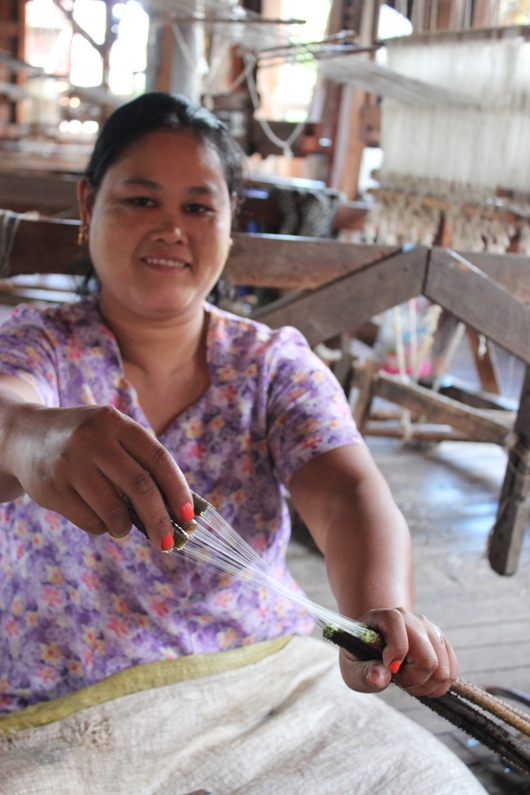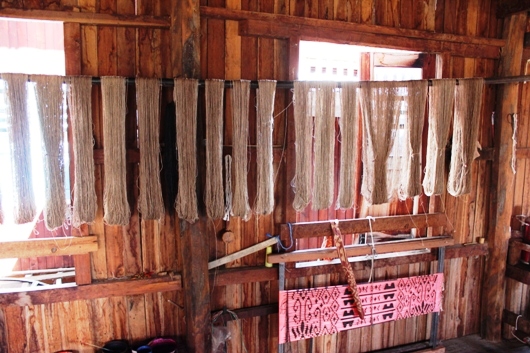The Artisans of Burma (Myanmar)
As we explored Myanmar (Burma) far and wide we became increasingly intrigued to find out just how skilled the Burmese people are. They quietly ply their crafts and are true artisans of their trade. From inside humble workshops, magic is created and marvellous things are formed. By travelling around, testing out some of our private luxury tours that can be enjoyed, we were fortunate to be able to see numerous skilled workers in action. As I watched them go about their work I was fuelled by a desire to immerse myself in the worlds that these experts inhabited. It would be a shame not to share some of what we discovered…
Palm Toddy Farm (Bagan)
Just outside the wonderland of temples in Bagan, Myanmar, we had the pleasure of visiting a local family who were running their own farm and business producing an array of products from the versatile toddy palm trees. The best known product from this native palm is the ‘toddy juice’. We watched as an agile young man clambered up the trunk in Mowgli style to bring us a taste of this sweet and refreshing nutty liquor. It has an unusually subtle taste that surprised us. However, we were more surprised by the potency of the alcohol that is created from the toddy juice after fermentation – we were convinced that any more than a sip would leave us walking in zig zags back to the car…
Toddy juice has been referred to in stone inscriptions since the Bagan era, nearly a thousand years ago. Records tell us that toddy plantations were given as gifts, but it is a mystery how anyone came to discover the method for extracting the juice from the palms.
When the toddy palm juice is boiled down it becomes increasingly sticky and honeyed eventually turning into jaggery - the ‘toddy candy’. We watched as the daughter of the family stirred and mixed a cauldron of hot jaggery incorporating shards of coconut and chopped dried plums into moreish ‘special’ candies.
After having the privilege to be shown the numerous mechanisms and techniques that are used by the family to eek the most out of the palm toddies, we were treated to the typical Burmese green tea leaves and given a complimentary foot massage before our departure. If only this happened in London…
Lacquer workshop (Bagan)
I had no idea of the workmanship that goes in to creating authentic lacquerware. Detail and considerable expertise are required and the process is truly fascinating. The traditions of this craft can be dated back to the 12th and 13th century in Bagan, although interestingly enough none of the raw materials used come from the surrounding area. All are imported from other parts of Burma and are transported mostly along the winding rivers from the Chin state.
To make lacquer there are a number of different steps and a different skilled worker is essential to each. To start, thin strips are shaved off a bamboo stick and then woven together to create the initial structure of the intended final product. Often horse hair is then interlaced in between the bamboo skeleton to create a uniquely flexible and pliable material – this technique is much more time-consuming than making the vessels only of bamboo and requires individual skills. Consequently, the horsehair cups and bowls are more expensive and mostly produced by only one or two skilled workers.
After this initial process, the interior of the vessel is covered with thayo, a paste made of lacquer sap that has been mixed with ash and this is repeated numerous times – drying, smoothing and re-laquering. The number of times this is done determines the quality of the finished article. Once application is complete, the vessel must be dried in dark and humid conditions, away from sunlight. Once dried completely, the exterior is coated in lacquer paste and then returned to the cellar for further drying out. The entire process before the article actually reaches the point of decoration is remarkably lengthy and requires an enormous attention to detail. When we then saw the concentration that goes into the engraving and decorating of the lacquer we were even more in awe of the humble workshop by the side of the road where it all takes place.
So, by the time we were led into the next door room where the lacquer products are for sale, we were like children in a candy shop and couldn’t believe the beauty of what we found.
This was such a highlight for me and to learn about the intricacies and skill that goes into the creation of this ancient old craft was a real delight and privilege.
Gold leaf hammering (Mandalay)
Gold leaf is to Burma what curry is to India – plentiful and ubiquitous. It gilds the glorious pagodas and embellishes traditional lacquerware; step inside temples and you will see locals rubbing small squares of gold leaf on the Buddha as an offering; if you walk down the roads of Mandalay you will marvel at the beauty of the local women whose natural features are enhanced by the gold leaf that adorns their faces.
Whilst in Mandalay we stopped at a gold leaf ‘manufacturer’ to discover how much time and physical effort goes in to creating the final whisper thin state of gold leaf. To begin, 3 ‘tickles’ (about 1.928 ounces) of gold bullion is placed in an extruder where a 20 foot long ribbon of gold comes out that is about ¾ inches wide. This strip is then cut into 5 foot pieces and then again into another 200 equal pieces of gold. Each slice is then placed between two sheets of bamboo paper, all 200 separated gold pieces are then stacked on top of one another and secured into a bundle. This handy little parcel of gold is then strapped onto a humble slab of rock. At this point a man straddles the rock, lifts a 6 lb hammer and beats the gold continuously for half an hour.
Once cut down, the initial 200 pieces have been transformed into 1,200 sheets of gold – it is beaten again. It is tiring just watching these men. At any one time there are at least 4 strapping fellows using brute force to continue the process. Thousands of swings take place in these basic working conditions and the longer you observe, the lazier you feel…
After a second pounding is complete, every fifth gold flake of the 1,200 pieces is cut into another 3 so that a further 720 flakes have been created. Unbelievably, another 5 hours of hammering takes place.
Finally, what has been created by this remarkable effort is taken into a next door room to be delicately packaged up by a group of women. It is their turn to make sure each precious piece of gold leaf is expertly placed between clean sheets of paper and tied together with thread to be distributed throughout the country.
I’m exhausted just writing this…
Lotus weaving (Inle Lake)
The lotus plant is to Inle Lake what gold leaf is to Burma! This particular flora is recognised as a great symbol for the possibility of life. Although the roots of the plant are buried deep under the mud of the lakebed what we see is the radiant blossom – a clear signal that there is always more to something than what it is we first see.
You will find numerous different artisans plying their craft around Inle Lake, but it was the lotus weaving that most captured my imagination. Housed in an unassuming wooden structure that emerges on stilts from the waters of the lake, the lotus weaving workshops are a tranquil hub of activity. I was entranced watching how, by cutting and carefully pulling apart the stem of harvested lotuses what appears are fine fibres that can be rolled and rubbed on a basic stone to create a wonderfully strong thread.
The lotus thread is then expertly woven on wooden, hand operated machinery into fabrics that go on to create a stunning array of scarves, shirts, jackets and neckties. Most of all I loved the exquisite robes that are produced especially for the holy monks of Burma. Only natural dyes are used to colour the textiles and the lotus weavers believe that by wearing something made from the lotus the bad energies that inhabit our bodies can be absorbed and we will be brought good luck. My new lotus woven scarf is now a favourite item of my wardrobe, unique to Burma and unique to me.
These four examples are just a drop in the ocean and really I would also like to tell you about the paper making, bamboo hat weaving, silversmiths and silk workshops… However, time is of the essence and the only thing to do is to go and discover the myriad of other artisans of Burma yourself - after all that is what luxury travel is all about.
For more information or to start planning your tailor-made holiday to Burma, please get in touch with us:
info@ampersandtravel.com / +44 (0) 207 819 9770

